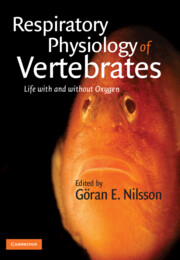3 - Oxygen uptake and transport in water breathers
Published online by Cambridge University Press: 05 June 2012
Summary
Introduction
Empirical studies of O2 uptake and blood O2 transport in fish began at least 100 years ago with the pioneering work of August Krogh (Krogh, 1904; Krogh and Leitch, 1919), who in 1941 published the seminal book on comparative respiratory physiology (Comparative Physiology of Respiratory Mechanisms, 1941). Catalyzed by the research of later-generation visionaries (van Dam, Scholander, Dejours, Johansen, Hughes, Shelton, Piiper, Randall, and Simpson), extensive research continues to examine the mechanisms of O2 uptake and transport within the blood of fish. In this chapter we focus our attention on O2 uptake and blood O2 transport in entirely aquatic water-breathing fishes; Chapter 4 is devoted to modes of O2 uptake in air-breathing fishes. Although some water-breathing species use skin as a supplementary route of O2 uptake (Graham, 1997) (see Chapter 6), the gill is the predominant organ for gas transfer. Thus, in this chapter we will focus exclusively on the gill. Numerous reviews have been written previously on branchial O2 uptake and blood O2 transport (e.g. Jones and Randall, 1978; Randall et al., 1982; Randall and Daxboeck, 1984; Malte and Weber, 1985; Butler and Metcalfe, 1988; Weber and Jensen, 1988; Cameron, 1989; Nikinmaa and Tufts, 1989; Perry and Wood, 1989; Piiper, 1989; Piiper, 1990; Randall, 1990; Thomas and Motais, 1990; Jensen, 1991; Nikinmaa, 1992; Thomas and Perry, 1992; Fritsche and Nilsson, 1993; Perry and McDonald, 1993; Nikinmaa and Boutilier, 1995; Val, 1995; Brauner and Randall, 1996; Gilmour, 1997; Nikinmaa, 1997; Val, 2000; Nikinmaa, 2001; Perry and Gilmour, 2002; Jensen, 2004; Graham, 2006; Nikinmaa, 2006).
- Type
- Chapter
- Information
- Respiratory Physiology of VertebratesLife With and Without Oxygen, pp. 49 - 94Publisher: Cambridge University PressPrint publication year: 2010
References
- 14
- Cited by

